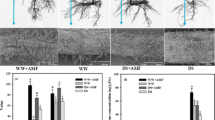Abstract
Two similar inclined boxes were constructed differing in several aspects from one developed earlier to regulate soil moisture potential. Each box had six 10-cm wide compartments with a perforated plastic cover. Boxes were placed in a room held at 10°C with a RH of 90%. The differential perforations in the plastic that covered the soil surface regulated evaporation which in turn regulated soil moisture. One box was used to carry out experiments on five herbicides at different matric potentials while the other box was used to test five mycoparasites. The herbicides chlorsulfuron, cyanazine, metribuzin, triallate and trifluralin significantly reduced the carpogenic germination of sclerotia of Sclerotinia sclerotiorum. Among five mycoparasites, Coniothyrium minitans completely inhibited germination. Penicillium sp., Sporidesmium sclerotivorum and Teratosperma oligocladium reduced germination in one of the two tests. The influence of soil moisture on carpogenic germination was significant in all tests. There were interactions between herbicides and moisture and also between mycoparasites and moisture. However, soil moisture did not have a marked effect on the efficacy of herbicides and mycoparasites.
Similar content being viewed by others
References
Adams P B and Ayers W A 1981 Sporidesmium sclerotivorum: Distribution and function in natural biological control of sclerotial fungi. Phytopathology 71, 90–93.
Ayers W A and Adams P B 1981 Mycoparasitism of sclerotial fungi by Teratosperma oligocladium. Can. J. Microbiol. 27, 886–892.
Cerkauskas R F, Verma P R and McKenzie D L 1986 Effects of herbicides on in vitro growth and carpogenic germination of Sclerotinia sclerotiorum. Can. J. Plant Pathol. 8, 161–166.
Duczek L J 1981 Number and viability of conidia of Cochliobolus sativus in soil profiles in summerfallow fields in Saskatchewan. Can. J. Plant Pathol. 3, 12–14.
Dueck J and Sedun F S 1983 Distirbution of Sclerotinia sclerotiorum in western Canada as indicated by sclerotial levels in rapeseed unloaded in Vancouver, 1973–1981. Can. Plant Dis. Surv. 63, 27–29.
Dueck J, Morrall R A A and McKenzie D L 1983 Control of Sclerotinia sclerotiorum in rapeseed with fungicides. Can. J. Plant Pathol. 5, 289–293.
Huang H C 1978 Gliocladium catenulatum: hyperparasite of Sclerotinia sclerotiorum and Fusarium species. Can. J. Bot. 56, 2243–2246.
Huang H C 1980 Control of sclerotinia wilt of sunflower of hyperparasites. Can. J. Plant Pathol. 2, 26–32.
Katan J and Eshel Y 1973 Interactions between herbicides and plant pathogens. Residue Rev. 45, 145–177.
Koorevaar P, Menelik G and Dirksen C 1983 Elements of Soil Physics. Elsevier Science Publishing Company Inc., New York. 228 p.
Morrall R A A and Dueck J 1982 Epidemiology of sclerotinia stem rot of rapeseed in Saskatchewan. Can. J. Plant Pathol. 4, 161–168.
Radke V L and Grau C R 1986 Effects of herbicides on carpogenic germination of Sclerotinia sclerotiorum. Plant Disease 70, 19–23.
Rai J N and Saxena V C 1975 Sclerotial mycoflora and its role in natural biological control of ‘white-rot’ disease. Plant and Soil 43, 509–513.
Teo B K and Morrall R A A 1985a Influence of matric potentials on carpogenic germination of sclerotia of Sclerotinia sclerotiorum. I. Development of an inclined box technique to observe apothecium production. Can. J. Plant Pathol. 7, 359–364.
Teo B K and Morrall R A A 1985b Influence of matric potentials on carpogenic germination of sclerotia of Sclerotinia sclerotiorum. II. A comparison of results obtained with different techniques. Can. J. Plant Pathol. 7, 365–369.
Tu J C 1980 Gliocladium virens, a destructive mycoparasite of Sclerotinia sclerotiorum. Phytopathology 70, 670–674.
Turner G J and Tribe H T 1976 On Coniothyrium minitans and its parasitism of Sclerotinia species. Trans. Br. Mycol. Soc. 66, 97–105.
Williams J R and Stelfox D 1979 Dispersal of ascospores of Sclerotinia sclerotiorum in relation to sclerotinia stem rot of rapeseed. Plant Dis. Reptr. 63, 395–399.
Author information
Authors and Affiliations
Rights and permissions
About this article
Cite this article
Teo, B.K., Verma, P.R. & Morrall, R.A.A. The effects of herbicides and mycoparasites at different moisture levels on carpogenic germination in Sclerotinia sclerotiorum . Plant Soil 139, 99–107 (1992). https://doi.org/10.1007/BF00012847
Received:
Issue Date:
DOI: https://doi.org/10.1007/BF00012847




